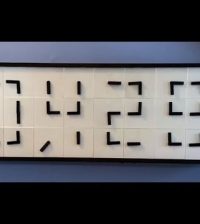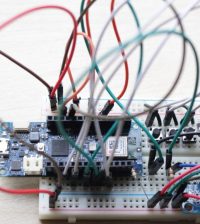- How to Adjust X and Y Axis Scale in Arduino Serial Plotter (No Extra Software Needed)Posted 4 months ago
- Elettronici Entusiasti: Inspiring Makers at Maker Faire Rome 2024Posted 4 months ago
- makeITcircular 2024 content launched – Part of Maker Faire Rome 2024Posted 7 months ago
- Application For Maker Faire Rome 2024: Deadline June 20thPosted 8 months ago
- Building a 3D Digital Clock with ArduinoPosted 1 year ago
- Creating a controller for Minecraft with realistic body movements using ArduinoPosted 1 year ago
- Snowflake with ArduinoPosted 1 year ago
- Holographic Christmas TreePosted 1 year ago
- Segstick: Build Your Own Self-Balancing Vehicle in Just 2 Days with ArduinoPosted 1 year ago
- ZSWatch: An Open-Source Smartwatch Project Based on the Zephyr Operating SystemPosted 1 year ago
Arduino NeuroRobotic shield: robots for all!
The “one man band” of the open source hardware robotics solution. With this shield, making your own robot is plain sailing!
The DynamixShield is an electronics board that fits onto an Arduino Due microcontroller to give you the ability to control Dynamixel smart servos and regular servos, while also providing numerous Grove and RobotGeek connectors. Grove and RobotGeek are hardware frameworks for modular sensors and actuators. There are tons of off-the-shelf modules for these two frameworks that can be plugged into the shield with a single cable. This includes everything from GPS sensors, RFID scanners, and LCD displays that are plug-and-play ready for use with the shield. This makes it very easy to build your robots by combining modules and servos.
Here is a complete list of its features:
- 4 Dynamixel servo connectors.
- A jumper for each Dynamixel connector to power it from the shield or an independent supply.
- 7 Digital Grove connectors (14 total signal lines, 2 per Grove connection).
- 6 of the Digital lines can be used for pulse-width modulation (PWM) to control regular servos.
- 4 Analog Grove connectors (8 total signal lines).
- 2 Independent serial Grove connectors.
- 2 Independent I2C Grove connectors.
- 19 Digital 3-pin connectors.
- 12 of the digital 3-pin connectors are PWM for control of regular servos.
- A jumper to control the power source for PWM header lines.
- 12 Analog to digital 3-pin connectors.
- A jumper to route battery supply to Vin of Arduino.
- All of these digital lines, including serial and I2C, are level shifted to 5V.















